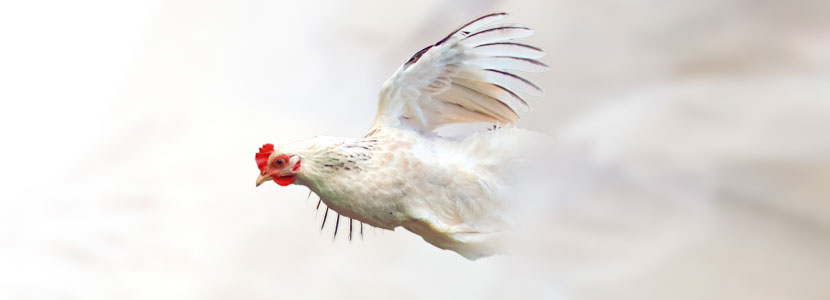Content available at: Español (Spanish) Português (Portuguese (Brazil))
- Traditionally it is said that the consequences of flapping are that wings get damaged in varying degrees of severity. However, by analyzing the situation closely, it can be concluded that there are costlier side effects in terms of other body parts affected and that have a higher commercial value.
Dear reader, with this suggestive title, I would like to draw your attention to the great importance of this reaction of chickens when they are under stress during pre-fattening, fattening and processing.
Traditionally it is said that the consequences of flapping are that wings get damaged in varying degrees of severity. However, by analyzing the situation closely, it can be concluded that there are costlier side effects in terms of other body parts affected and that have a higher commercial value.
The flapping “chain reaction” starts in the houses, the result of visits by farm staff for daily monitoring of chickens on farms. Staff must enter the houses to inspect if all equipment are working normally, as well as the uniformity and vitality of the flocks. In addition to collecting mortality, etc., it involves walking amongst the birds. If the personnel do it moving at their normal pace, the birds will change their normal calm behavior, to a state of maximum alert which is manifested by fast escapes and short bursts of flight, which they end up landing on the back of neighboring birds.
When chickens land on the backs of their companions they scratch them, because they try to hold on so as not to fall. This can lead to infections, taking a toll on the quality of the eventual processed carcass, whose level must be Grade A. Simultaneously, repeated flapping causes physical damage to their wings and the bodies of birds in close proximity. And should they all flap simultaneously, their wings will get damaged both internally and externally.
HEAVY BIRDS
In heavier birds, this situation becomes more critical, because the capillary vessels that transport nutrients, oxygen and/or carbon dioxide and metabolic waste are ruptured releasing part of the circulating blood and forming large hemorrhages.
LIGHT BIRDS
In lighter birds, the hemorrhages are smaller. These impacts on the quality of the carcasses, in most cases are detected during the stripping and/or deboning. However, there are some blood vessels that rupture during processing as well.
Based on what was said in the preface, if intense flapping appears during the capture and caging of the chickens, the sequence of damage to the quality of the animals that are going to arrive at the plant explained above will be repeated. The hematomas and hemorrhages will be of a darker discoloration. In the processing plant, if the physical and operational infrastructure is not adequate, flaying will occur again in the following scenarios:
- Inadequate darkening at the plant
- Improperly adjusted breast massager
- Chicken size that exceeds available space when shackles are 6 inches apart.
Birds hanging on the slaughter air carrier belt.
There are a lot of curves along the way once hanging the birds up to the entrance of the stunner tub. The changes of direction create additional stress for the birds, due to action of centrifugal force, the animals separate for a few seconds from the breast massager, feeling unprotected. Pre-shock at the entrance to the tub – stunner bathtub – Exit from the tub : Tonic Phase – chickens flinch. Sometimes with great intensity which includes flapping.
Due to insufficient stun processing at high speeds, it is not possible to remove birds that are still conscious from the hooks. hence, they must be sacrificed in that position. Consequently, at full consciousness, they will feel a lot of pain, which is manifested by intense twisting and flapping.
Create a basic culture so that on farms, once the personnel enter the houses to perform their daily duties, walk slowly similar to the chickens. By doing so, the birds will remain calm, assuming that the presence of those responsible for caring for them are simply larger animals than them. Same must be done during their capture and caging.
With this new business mindset, wing damage, a part of the birds that is in greater demand every day, must be reduced as much as possible. The flip-side of the coin is hemorrhages and hematomas that are caused at the level of the breasts.
In this way, there will be more kilos of chicken meat sent by the farms and transformed into very good quality products.

